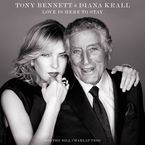Tony Bennett & Diana Krall - Love Is Here To Stay
Tony Bennett & Diana Krall - Love Is Here To Stay
Verve / Universal
Veröffentlichung: 14. September 2018
To have Tony Bennett and Diana Krall celebrate the music of The Gershwins for an album honoring George’s 120th Birthday (Sept. 26, 2018) is quite simply: “S’Wonderful”
George Gershwin was the most ambitious and diverse of 20th century music-makers, rivalled only by Duke Ellington and Leonard Bernstein. Gershwin’s music seemed to belong everywhere and anywhere: on the Broadway stage and the silver screen; in the dance halls and the concert halls, on radio, television, and the internet; in the ballroom, in the bedroom, and even the boardroom. More than any other songwriter, his work has been played by jazz bands and symphony orchestras, and sung by pop singers, jazz singers, and even blues singers and opera singers. When a South African folk singer or a Hindi or Chinese pop star sings “Summertime” in their native language, nobody is surprised.
Perhaps even more importantly, within the course of his short lifetime (38 years, from 1898 to 1937), George Gershwin became a symbol of human achievement: for the music industry, for immigrant families, for New Yorkers, for Americans, and all citizens of the world. In an age when songwriters mostly toiled in obscurity - overshadowed by the singers and bandleaders who performed their music - Gershwin was a widely beloved international celebrity. At the moment of his tragically early death, the great American writer John O’Hara - a hard-bitten pessimist famous for his rather cynical novels - famously proclaimed that he didn’t have to believe it if he didn’t want to.
George Gershwin was born Jacob Gershwine on September 26, 1898, the second son of Rose and and Morris Gershwine (originally Gershowitz), who had arrived in New York only a few years earlier, fleeing the state-authorized persecution of Jews in Czarist Russia. The family was residing on Snediker Avenue in Brooklyn at the time, but Morris frequently changed jobs and the Gershwins changed lodgings accordingly. George’s older brother Ira, became interested in music well before George did; the story goes that the family scraped their money together to buy a secondhand piano for Ira, and then were much startled when eleven-year-old George sat down to play it.
Gershwin originally was self-taught as a pianist and an aspiring composer, as indeed, were most songwriters of his generation. What distinguished Gershwin from his contemporaries was that throughout his life, he was constantly learning, continually seeking out ever-better instructors, as he moved from playing the piano to writing songs to scoring and orchestrating formal compositions. By the time he was 15 in 1913, Gershwin was already known as a local piano prodigy, and was helping to support the family (which now included three boys and one girl), by working as a music demonstrator - or “song plugger” as they were called - in a music publisher’s office. He wrote his first song at 17, the long forgotten "When You Want 'Em, You Can't Get 'Em, When You've Got 'Em, You Don't Want 'Em,” which netted him the princely sum of fifty cents. Around this time, he also began earning extra income by producing rolls for player pianos.
In 1919, Gershwin landed his first, and, in many ways, the biggest hit of his lifetime, “Swanee.” Supposedly, he and the young lyricist Irving Caesar wrote most of it together on a bus ride together in under ten minutes. When the legendary Al Jolson heard the song, he was so immediately impressed that he incorporated it into his Broadway show Sinbad, thus becoming the first of many superstars to take up Gershwin’s music. Even at this early stage, the young composer was interested in forms of music beyond the popular song, and was already writing works like his ragtime instrumental “Rialto Ripples” (1917) and his chamber music-style “Lullaby” (1919).
Still, it was the success of “Swanee,” that led to steady work from other Tin Pan Alley publishers and Broadway producers. At the start of the roaring ‘20s, Gershwin and his first regular collaborator, lyricist (and future Hollywood producer) B. G. “Buddy” DeSylva, wrote mostly for revues. Some of their early successes include “Do It Again” (from The French Doll, 1921), and a series of songs written for The George White Scandals, most mostly famously “I’ll Build a Stairway to Paradise.” Throughout his career, Gershwin was always looking for something new, and while writing songs for the Scandals, he persuaded the producer to let him try his hand at writing an opera. This first experimental “jazz opera” was titled Blue Monday and it was included in the 1922 edition of the Scandals; it inspired the show’s conductor, Paul Whiteman, to conceive of an even more significant project.
In 1924, Gershwin reached his first of many peaks of artistic maturity: as a Broadway tunesmith, this was the moment when he began a permanent, full-time collaboration with his most perfect partner, his brilliant older brother, Ira Gershwin. Their first show together was the 1924 Lady, Be Good!, which was also a breakthrough for another pair of siblings, the rising song-and-dance team of Adele and Fred Astaire. The score, which included such classics as “Fascinating Rhythm,” “The Man I Love” (which was cut from the show and not heard until a few years later), and the title song, “Oh, Lady Be Good,” proved that George and Ira were indeed a magical team - no less than Fred and Adele.
In that same year, Gershwin was also commissioned by the most famous bandleader of the day, Paul Whiteman (whom he first worked with on the Scandals) to compose a classically-influenced composition for performance in a formal concert hall. This was, indeed, a far cry from the 32-bar popular songs that were either sung on Broadway stages or meant for inspiring the charleston in dance halls. This became the Rhapsody in Blue, introduced by Whiteman’s Orchestra with the composer himself at the piano in March 1924. Overwhelmingly successful, this has become, over the last 95 years, perhaps the most famous piece of “classical” music ever written by any American composer, with themes and motifs that are instantly recognized by almost everybody.
For the rest of his career, Gershwin would alternate between popular songs, generally written for shows and later films, and “serious” works like rhapsodies, concertos, ballets, and, ultimately his grand opera. In fact, he was already thinking about Porgy and Bess as early as 1926 when he first read DuBose Heyward’s original novel Porgy. In the late 1920s, George and Ira went from strength to strength on Broadway: Oh Kay! (1926) starred the great british entertainer Gertrude Lawrence and introduced “Someone to Watch Over Me” and “Clap Yo’ Hands”; Funny Face (1927) reunited the Gershwins with the Astaires and brought forth “S’Wonderful,” “He Loves and She Loves,” “How Long Has This Been Going On?”
In 1930, the brothers wrote what became their most famous musical comedy, Girl Crazy, which co-starred two future stars in Ethel Merman and Ginger Rogers, was eventually filmed three times by Hollywood, and introduced more great songs than practically any show ever: “But Not For Me,” “Embraceable You,” “Bidin’ My TIme” and the all-time jazz standard, “I Got Rhythm.” (Even more than “Oh, Lady Be Good,” this is the song that launched a million jam sessions.)
In these same years, Gershwin also wrote most of his best-known concert works: the Concerto in F for piano (1925) and the single most famous American ballet, An American in Paris (1928). Later concert pieces include the lesser-known Second Rhapsody (aka New York Rhapsody, 1931), the ingeniously multicultural Cuban Overture (1932), as well a brilliant set of solo piano “preludes.” In response to the Great Depression, the Gershwin brothers spent most of the early 1930s working on four very different musical comedies, a series of highly topical political satires mostly with librettos by the lauded playwrights George S. Kaufman and Moss Hart: Strike Up the Band (1927 & 1930), Of Thee I Sing (1931), Let ‘Em Eat Cake (1933), and Pardon My English (1933). Of these, the second was the most successful, capturing the sarcastic mood of the era and earning a pulitzer prize. (Among other great songs, these shows introduced “Who Cares,” “I’ve Got a Crush on You,” “Soon,” and the contrapuntal “Mine.”)
By this point, Gershwin was obsessed with the work that was destined to become his masterpiece. The two brothers formally began their collaboration with the writer DuBose Heyward in 1933; their goal was nothing less than to adapt his best-selling novel, Porgy (1925), into a full-scale grand opera. Their first step was to visit the African American communities of the Georgia Sea Islands, where the original novel was set, to soak up the music and the local color.
Rather incredibly, during this same period when he was writing Porgy and Bess, Gershwin also embarked on a concert tour as a solo pianist (starting in January 1934); of all the major songwriters and Broadway composers, Gershwin alone was a virtuoso instrumental soloist. Even now Gershwin was surrounded by a major pool of talent: the famous bandleader Leo Reisman assembled the orchestra, Charles Previn (uncle of Andre Previn) conducted, and the principal oboist was a 23-year-old multi-reed specialist named Mitch Miller, who would go on to produce hits for Tony Bennett (among many others) at Columbia Records. (Gershwin’s social circle was even more stellar, and young songwriters like Vernon Duke, Johnny Green, Oscar Levant, Burton Lane, to name just a few, flocked around Gershwin for advice and support.) Gershwin’s biggest showpiece during the 1934 tour was a set of Variations on I Got Rhythm, that brilliantly combined jazz and classical keyboard fireworks.
It seems hard to believe that Porgy and Bess - nothing less than the great American epic and the climax of Gershwin’s career - was somehow created in less than two years. This is all the more remarkable because, unlike The Rhapsody in Blue, for instance, Gershwin scored the entire orchestration himself. Billed as a “folk opera,” Porgy and Bess ran for 124 performances on Broadway, which was not considered a success for a musical comedy, but was a rather good run for an opera. Over the decades, the work has increasingly grown in stature and importance, and has long since assumed the stature of the greatest of American operas. Such songs as “I Got Plenty o' Nuthin',” “It Ain't Necessarily So,” “My Man's Gone Now,” “I Loves You, Porgy,” “Bess, You Is My Woman Now,” and most of all, “Summertime” (with lyrics by Heyward), the beautiful lullaby that opens the work, have become some of the most iconic songs in the history of the world.
Though it eventually became a classic, Porgy and Bess did not recoup its original investment on Broadway, and as a result, George and Ira concentrated on opportunities in Hollywood, writing songs for movies, from 1935 to 1937. They primarily worked on three films, two of which starred their old friend Fred Astaire, Shall We Dance and A Damsel in Distress (both 1937). These final projects contain a disproportionate portion of the all-time great George and Ira Gershwin songs: “Let’s Call the Whole Thing Off,” “They All Laughed,” “They Can't Take that Away from Me,” “A Foggy Day (In London Town),” “Nice Work If You Can Get It,” and “Love Walked In.”
As early as 1934, Mitch Miller remembered, that Gershwin was, rather mysteriously, somehow complaining of weird afflictions and “smelling garbage” - that nobody else could smell. In the early Summer of 1937, his mental and physical condition began to rapidly deteriorate; he was suffering random bouts of depression and coordination problems that doctors couldn’t explain. It wasn’t until July 9, when he fell into a coma, that he was diagnosed with a brain tumor. George Gershwin never regained consciousness, and died on July 11, 1937, two months before his 39th birthday.
There was still more music ahead: Gershwin’s final score, for the film The Goldwyn Follies, would be heard in 1938. In 1946, the two people closest to George, his brother Ira, and his longtime lover, the composer Kay Swift, went to work on a series of unfinished ideas for songs that Gershwin had started, and created a whole new score out of them, for a 1947 movie musical entitled The Shocking Miss Pilgrim. And in future generations, there would be no shortage of Gershwin pastiche and biography films and shows: Rhapsody in Blue (1945), An American in Paris (film 1951, Broadway 2015), My One and Only (1983), Crazy For You (1992), and Nice Work if You Can Get It (2012).
Even so, the great composer’s most perfect epitaph comes from the title of the last song that Gershwin finished in his lifetime (from The Goldwyn Follies), “Love Is Here to Stay.”
(all music by George Gershwin; all lyrics by Ira Gershwin, unless noted)








